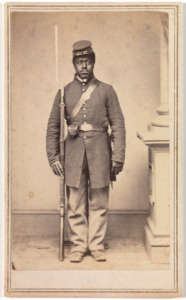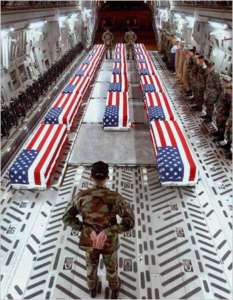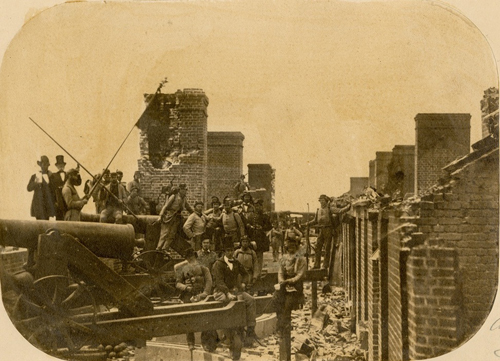The new medium of photography came into its own during the Civil War, capturing thousands of images of soldiers, statesmen, freed slaves, and devastated towns and cities. Its impact on public perception of war was dramatic, demonstrating the power of visual media to shape public opinion.

An exhibition at the Metropolitan Museum of Art in New York City entitled “Photography and the American Civil War,” which runs until September 2, 2013, lays bare the players and panoramas of the conflict. This wide-ranging portfolio shows that the camera did not avert its gaze from the most horrific scenes of destruction.
The smoke of gunfire still seemed to hang in the air as I gazed at wall after wall of victims on the battlefields of Gettysburg and Antietam and gutted-out buildings in Richmond and Atlanta. But scenes from actual battles were curiously absent. A poster explained why.
Photography in the 1860s was a cumbersome affair. A sheet of glass was used to capture the image, and it had to be coated with chemicals before exposure to the targeted subject. This labor-intensive process made it nearly impossible to keep pace with the frenzied action of battle. So photographers focused on still subjects. Buildings. Weaponry. Soldiers posing in their uniforms. Soldiers in encampments. Soldiers in hospitals. And most of all, soldiers lying dead across the South. The “missing” action made the devastation seem even greater, as if it had happened in an instant.

I was also struck by the vacant expressions on everyone from freed slaves to Union generals. Photographers back then didn’t instruct subjects to “Say cheese.” Victor and vanquished presented the same blank stare. This is hard to imagine in our era, when digital cameras and cell phones capture millions of trivial events daily and enshrine endless smiles on Facebook and Instagram. But there was a technical reason for the sameness of expression in the nineteenth century. Today, shutter speeds of 1/1000th of a second freeze the fastest action. Back then, it took exposure times of two to five seconds to preserve an image. A sudden move would blur the scene, so it was important for the subjects to remain rigidly still. That was easier to do with a neutral expression.
Some 150 years ago, people seeing photographs of the Civil War for the first time were transfixed. When photography pioneer Mathew Brady displayed images from the war in his New York City gallery in 1862, people lined up around the block to see them. For most, this was the only way to get a glimpse of the war zone. Previous perceptions of the war as a great adventure were shattered by the realism of death and ruins. As noted in a New York Times article in that era: “Mr. Brady has done something to bring home to us the terrible reality and earnestness of war. If he has not brought bodies and laid them in our dooryards and along the streets, he has done something very like it.”
This encounter with realism helped stir up Northern empathy for the families of the Deep South, who bore the brunt of the destruction. It also made it difficult to be neutral on slavery. Many Northerners who may never have seen slaves nonetheless considered them an inferior race. But a bounty of images of these people working on farms and for the war effort showed them to be not so different from themselves.

Visual media have continued to affect our perception of war over the years. As photography became less complex, photojournalists could venture onto the battlefield. Newsreels from the European and Pacific fronts of World War II finally brought the action of battle to enthralled audiences. That coverage supported the widespread patriotism of the time, but reporting on the Vietnam War in the 1960s and 1970s was a different story. For the first time, television news brought a steady stream of war footage into our living rooms nightly, without censoring scenes of brutality on either side. This saturation coverage played a key role in turning the tide of public opinion against the war.
The gritty realism of this reportage contrasts starkly with the media coverage of the first Persian Gulf War in 1991. The evening news then was dominated by aerial views of “smart bombs” hitting their targets on the ground in Iraq with dead-on accuracy. This war was made to look like a video game, with no displays of bloodshed or close-up views of the damage. Could this sanitized coverage have been a presumptive strike against dissent?

Objective coverage took another giant step backward during the Iraq War that began in 2003. Unlike in Vietnam, when flag-draped caskets of the slain were shown routinely, the political administration forbade such scenes from making their way to media outlets in the new century.
The message for viewers is clear: we should be mindful of what the media shows us, as well as what it doesn’t. Newscasts can skew our perception of what’s going on in the world, making any situation look worse or better than it really is. What’s happening off camera may be as important as what’s captured by the lens.




1 Comment
Holly Scott
Well said. The media’s power to skew our perceptions is so strong.
Just read about photographer David Jay’s The Unkown Soldier project.
http://shutr.bz/14b7BRT
One of the goals of his project is to allow the public to see actual, current consequences of war.